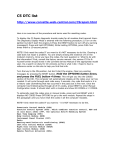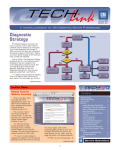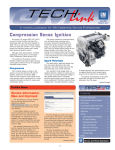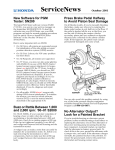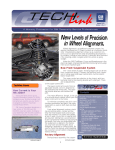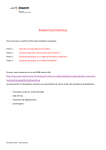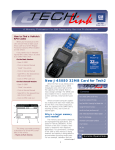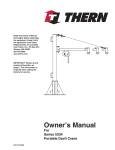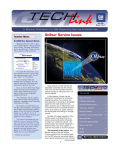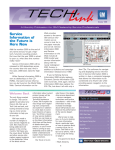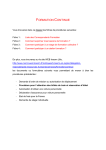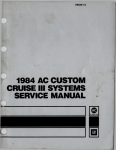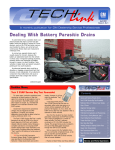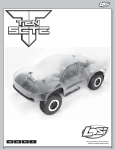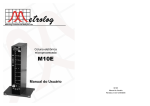Download Quadrasteer™ Rear Wheel Steering Introduced
Transcript
December 2001 Volume 3, No. 12 A monthly publication for GM Dealership Service Professionals Quadrasteer™ Rear Wheel Steering Introduced A revolutionary new rear wheel steering system is standard equipment on the 2002 GMC Sierra Denali pickup truck. Quadrasteer reduces the diameter of the turning circle by 3 m (10 feet), so it’s comparable to that of a compact car. In addition, it contributes to stability on the highway and maneuverability when towing a trailer. All of this is accomplished by a rear axlemounted rack and pinion steering gear operated by a computer-controlled electric motor. Operation Quadrasteer operates in three ”phases:” Negative Phase -- At low speeds, up to 72 kph (45 mph), the rear wheels steer in the opposite direction of the front wheels Neutral Phase – At moderate speeds, about 72 kph (45 mph), the rear wheels remain straight. This is also the failsafe phase in case of system problems. continued on page 3 Techline News 32 MB CARD one J-45080 32 MB card to replace the 10 MB card. TIP: See the 32 MB article in the April, 2001, issue of TechLink on the service.gm.com website. TIP: The Tech 2 requires a linear flash card. The low-priced 32 MB strata cards available on the internet will not work. The new 32 MB card is shipped with startup software installed, and should be inserted in Slot 1, closest to the screen. TIP: When updating the 32 MB card for the first time and using TIS 2000, remember to select the Custom Mode. In the April, 2001, issue of TechLink, you learned that the days were numbered for the 10 MB (megabyte) card in your Tech 2. With the ever-expanding use of on-board computers, there’s no longer enough room on the 10 MB card. Beginning last April, all new Tech 2s are being shipped with a new 32 MB card installed. Also, each dealership received You MUST have the 32 MB card installed before updating your Tech 2 again. The update will be broadcast on GM ACCESS on January 14, 2002, and will be included on CD no. 1 for 2002, shipped on January 17, 2002. This update WILL NOT fit on the 10 MB card. What Will Happen to the 10 MB Card? It’s recommended that you keep the continued on page 2 1 Contents Quadrasteer Rear Wheel Steering Introduced . . .1 Techline News 32 MB Card . . . . . . . . . . . . . . . . . . . . . .1 Making a Duplicate Card . . . . . . . . . . . . . .2 Freeze Frame . . . . . . . . . . . . . . . . . . . . . .2 Class 2 Tip of the Month . . . . . . . . . . . . . . . . .2 DVD Navigation System for 2002 . . . . . . . . . . .4 Proper Removal of O2 Sensors . . . . . . . . . . . .5 Top Post Battery Introduced . . . . . . . . . . . . . . .6 Tech Tips Park Brake Specifications . . . . . . . . . . . . . .3 Noise in Strut Support . . . . . . . . . . . . . . . .6 Ignition Key Binds . . . . . . . . . . . . . . . . . . .6 Cruise Control Switch Inoperative . . . . . . . .6 AWD Rear Drive Axle Fluid Requirements . . .6 Allison LCT 1000 Transmission . . . . . . . . . . . .7 Test Lamp Technology . . . . . . . . . . . . . . . . . . .7 Bulletins . . . . . . . . . . . . . . . . . . . . . . . . . . . .8 Service Operations Techline News continued from page 1 latest update on the card until told to do otherwise. GM Service Operations recently conducted a survey of Tech 2 users, asking for ideas about what to do with the 10 MB card. These ideas and comments are being reviewed, and you will be notified as soon as a decision is made. MAKING A DUPLICATE CARD Once you have updated a card, you can use this timesaver “copycard” procedure to make duplicates. One card (the source) has the programming you want to copy onto the other (the destination). You can can put either card in either slot. TIP: Be sure the cards are seated properly. Improper seating will cause error messages to appear. Also, use caution and make certain that the card is properly aligned with the guides in the Tech 2 card ports. Failure to properly align the card may damage the card or the Tech 2. Follow this Tech 2 path: 1. Power up the Tech 2 to the log-on screen. Destination Card Too Small Press [ENTER] to continue (actually press the EXIT key) Be sure you have 32 MB cards in both slots, then start again. FREEZE FRAME In events that cause a vehicle’s emission system to malfunction, governmental OBD II requirements call for a freeze frame failure to be recorded in the PCM. Data parameters are caught at the time of failure and stored as a freeze frame. The freeze frame remains until you erase it, or it is overwritten by another event. When you capture a freeze frame failure record, you can download it to TIS 2000 and can view it. The data on PC screen appears in the same order as data on Tech 2. You can store the freeze frame on your PC, and can print it out for attachment to the repair order, for future reference. Here’s the path: 2. Use the shift key and the right or left arrow key to select the source card (the size of the card and version number will be displayed on the screen). TIP: Make sure you have the most current update loaded to your PC. There have been some improvements made to this feature, including increasing snapshot storage from 10 to 50 files. 3. Press [ENTER] 1. Connect Tech 2 to Techline terminal 4. F3: Tool Options (Main Menu) 2. Power up Tech 2 5. F7: Make Duplicate PCMCIA Card (Tool Options) 3. On Techline terminal, select TIS 2000 6. The screen will confirm the direction the data will flow. Press the COPY soft key to begin the copy function. 5. Download freeze frame failure record from Tech 2 to terminal TIP: You cannot copy from a 32 MB to a 10 MB card. If you try to do so, this message will appear: Every controller on the Class 2 bus has its own unique identification (ID) number. For instance, the PCM's ID number is 016 and the Instrument Panel's ID is 096. Understanding this concept makes it easier to understand the U-codes that will periodically set. For example, if a U1096 was set in the PCM, the PCM lost communication with the controller whose ID number is 096. In this case, the Instrument Panel Cluster. Looking at the service manual description for a U1096, it states that it is a "Loss of Communications from Instrument Panel". Here's a list of the more common controller and their IDs. 4. Click Snapshot icon 6. Now you can review, save, and print the file. – Thanks to Keith Armitage and Mark Stesney PCM – 016 BCM – 064 SDM – 088 TCS – 040 EBCM – 041 IPC – 096 Radio – 128 HVAC – 153 RFA – 176 TIP: Although these IDs are standardized, there may be variations depending on model. When a U-code sets, keep in mind that the controller setting the U-code is pointing to the controller causing the problem. The ID number given in the U-code tells you which controller is at fault. The Tech 2 or SI2000 can tell you which controller the ID number represents, but before long, it will become second nature. GM TechLink is a monthly magazine for all GM retail technicians and service consultants providing timely information to help increase knowledge about GM products and improve the performance of the service department. This magazine is a companion to the GM Edge publication. Publisher & Editor: Mark Stesney GM Service Operations [email protected] Technical Editor: Jim Horner [email protected] 1-248-816-3641 Production Manager: Marie Meredith Desktop Publishing: Greg Szpaichler, MediaWurks [email protected] FAX number: 1-248-649-5465 Write to: TechLink PO Box 500 Troy, MI 48007-0500 GM TechLink on the Web: http://service.gm.com General Motors service tips are intended for use by professional technicians, not a "do-it-yourselfer." They are written to inform those technicians of conditions that may occur on some vehicles, or to provide information that could assist in the proper service of a vehicle. Properly trained technicians have the equipment, tools, safety instructions and know-how to do a job properly and safely. If a condition is described, do not assume that the bulletin applies to your vehicle or that your vehicle will have that condition. See a General Motors dealer servicing your brand of General Motors vehicle for information on whether your vehicle may benefit from the information. Inclusion in this publication is not necessarily an endorsement of the individual or the company. Copyright© 2001 General Motors Corporation All rights reserved. – Thanks to Mark Harris 2 Return to page 1 QuadrasteerTM continued from page 1 Positive Phase -- At high speeds, above 72 kph (45 mph), the rear wheels turn the same direction as the front wheels. The Quadrasteer control module determines the phasing and amount of rear wheel steering based on the mode switch setting, position of the steering wheel and vehicle speed. mode provides more positive phase steering than the normal 4-wheel steering, and at low speed, similar negative phase steering as the normal 4wheel steering mode. For maximum benefit, 4-Wheel Steer is the recommended setting under most conditions. Diagnosis Operating Phases Detailed diagnostic procedures are included in SI 2000, and you should always follow the steps in the order published. Because Quadrasteer is part of the vehicle’s serial data system, you’ll use your Tech 2 to look for diagnostic codes. Rear / Front Stirring Ratio TYPICAL ALGORITHM Vehicle Speed (kph) Negative Phase Neutral Phase When moving forward, the rear wheels can steer up to 12 degrees. While standing still, or in reverse, the rear wheels can steer up to 5 degrees. A feedback signal is sent from the rear position sensor on the rack and pinion gear to confirm rear wheel position. Positive Phase TIP: The handwheel (steering wheel) position sensor provides four different outputs to the control module. One is analog and three are digital. These outputs indicate direction, speed, and amount that the steering wheel is being turned. TIP: Ordinarily only one mode indicator lamp is illuminated at a time. If all three are illuminated at the same time, a wheel alignment is needed. TIP: When the transmission is in neutral for 4 seconds, the system will default to 2wheel steer until the shifter is placed into gear again. This is to accommodate automatic car wash requirements, and is normal. Service Follow this path in SI 2000: – 2002 GMC Sierra – Steering – Rear Wheel Steering See SI 2000 for details. Here are some of the highlights. Lifting -- Because of the tie rod boots on the rear rack and pinion gear, it’s important to use caution when lifting with an in-ground hoist or using jack stands. See SI 2000 for details. Alignment -- There are provisions for toe adjustment only. Caster and camber are fixed. SI 2000 explains the detailed procedure for using the Tech 2 during the ”learn” procedure. Quarter Shafts -- The quarter shafts are equipped with constant velocity (CV) joints at the outer ends only. The CV joints are protected with rubber boots similar to those on front drive axles. Rear Actuator – In normal operation, noise from the actuator should not be audible; when the actuator is commanded by the Tech 2, some operating noise is normal. Steering Gear Motor – The electric motor is serviceable separate from the steering gear. When the motor is removed, the planetary gear reduction set is exposed, so care must be taken to avoid contamination. Tech 2 Functions – You can use your Tech 2 to read operating parameters. Also, you can command various functions so you can observe operation. These include mode indicator lamps, as well as steering in right and left directions. See SI 2000 for details. – Thanks to Jerold Miller TIP: A yaw rate and lateral accelerometer sensor is used only to monitor system behavior; its output is not used for operation. Mode Control Switch Driver Control A mode switch on the instrument panel allows the driver to select from three modes: – 2-Wheel Steer, in which only the front wheels steer – 4-Wheel Steer, in which rear steering is enabled Park Brake Specification Affected vehicles: 1997-2001 4X4 (T) Chevrolet Blazer, S-10, GMC Envoy, Jimmy, Sonoma, Oldsmobile Bravada After resurfacing a park brake drum on the rear rotor of the above vehicles, the maximum drum diameter should not exceed 191 mm (7.52 in). – Thanks to Dan Oden – 4-Wheel Steer Tow, in which rear steering is optimized for towing. At high speed this 3 Return to page 1 DVD Navigation System for 2002 audible voice prompts, so the driver needs to glance at the map only when necessary and it is safe to do so. TIP: The audible prompts are available in English, German, Spanish, French, and Japanese. Display screen tilted open for access to DVD player The navigation system provides voice recognition for hands-free operation of nearly every feature of the navigation system, radio, CD player and DVD player. This feature operates in the same way that the UV8 hands-free cellular telephone option works. A press of a steering wheel control button activates voice recognition. The system picks up voice commands through a microphone mounted in the rearview mirror, issues voice prompts through the vehicle audio system, and controls system functions. The system will mute the radio during the voice recognition process. The voice commands include HELP prompts, which may be activated at any time. After hearing the system’s READY prompt, a driver may say MAP HELP and the system will state all commands available for manipulating the map. Then saying ZOOM OUT (for example) while voice recognition is still active causes the system to perform that navigation map command. After a few seconds of silence, the voice recognition feature times out, and radio or CD play resumes. For 2002, the Cadillac DeVille and Seville will offer a new DVD Navigation System. Although there are a lot of important new features, perhaps the one the owner will notice first is that it requires only one map data disc to cover the entire continental US. No more having to carry a selection of discs and having to change them at state borders. This is possible because a DVD has a considerably larger storage capacity than the previously used CDs. The disc is loaded directly into the instrument panel unit, instead of a trunk mounted unit as in 2001. Quick Overview As before, the new navigation system uses a Global Positioning System (GPS) receiver to determine the car’s location. Then, using data from the DVD, it displays a map of that location. TIP: See the May 2001 issue of TechLink for a description of the GPS principle, which is also used by OnStar®. TIP: Although both the DVD Navigation System and OnStar use GPS technology, they have separate antennas. The navigation system GPS antenna is located in the rear parcel shelf, where it has an unobstructed view of the sky. When the driver inputs a destination, the equipment is able to provide turn-by-turn guidance, using both voice and map. In nondetailed areas, only map displays are available. Enhanced Features The driver and navigation system communicate with each other using a 6.5inch color VGA touch screen, which is considerably larger than last year’s model. For 2002, the navigation system consists of a single instrument panel mounted module, instead of two modules as in past years. The display screen contains controls for the radio, CD player and DVD player. The programming features of the navigation system are accessible only in Park, so the driver must program the desired route before driving off. Other DVD Features Navigation Features The DVD Navigation System is capable of storing personalized settings for each of three different drivers. These include audio presets for bass and treble, as well as navigation features. For instance, each driver can store 60 memory points, and can file them in predefined folders for business, entertainment, personal, etc. Each driver can specify display and map view characteristics as well. Voice Recognition control button on steering wheel To use these other features, the navigation DVD must be removed. Access to the DVD player is gained by pressing a hard key, which causes the display screen to tilt open. The hard key operates only with the transmission in Park. Press the hard key a second time to close the player; do not close it manually. The system will play conventional CDs any time the navigation feature is not in use. And when the shift lever is in Park, it will play DVD movies, using the display screen. TIP: The single CD slot in the navigation system is in addition to the conventional CD changer located elsewhere in the vehicle. Voice Recognition While underway, the system provides 4 Return to page 1 The main portion of the self test that you will use in diagnostics is the screen that shows satellite reception. This screen is also referenced in SI2000 when diagnosing "No GPS Reception." Diagnostic Menu display TIP: To obtain a replacement DVD Navigation System radio, call Specmo at 1.800.545.7910 to arrange an exchange unit. You need to call Specmo directly, as your local exchange center may not be familiar with this system. TIP: A customer may comment that there are no voice prompts in some rural areas. Point out that if the vehicle travels into an area which is non-detailed on the map, the system continues to track the location but will not provide voice prompts until it is back in a detailed area of the map. TIP: Because the DVD system uses a third-party data base, coverage detail varies with location. Roads are visible essentially everywhere in the US. Voice guidance and road detail are available only in detailed map areas. for map coverage information. TechLink will provide the web address when it becomes available. The system is capable of displaying both 2-D and 3-D map views, and 2-D and 3-D intersection guidance. Diagnostic and repair information can be found in SI 2000 under Body and Accessories then selecting Navigation Systems. Here you will find information about the system’s self test. When a route is plotted, the driver can specify 5 waypoints, permitting multiple stops on the trip. The display offers smooth and rapid zoom and scroll features. A web site will be set up later in the year Service Issues Enter the self-test by pressing and holding the audio adjust button until the keypad is displayed. Enter 1971 by touching the corresponding numbers displayed on the touch screen If there is no GPS reception, the navigation radio will set DTC B2462 when an open or a short is detected between the GPS antenna and NAV radio. If no DTC is set and there is no GPS reception, (refer to NAV self test), perform the following while monitoring the GPS Information screen: – Ensure the vehicle is parked in an open area free of any obstructions – Inspect the rear widow glass for tint or other obstructions – Remove the GPS antenna and place outside of vehicle – Refer to SI 2000 for additional steps – Thanks to Russ Gilbert, Paul Gallo and Trip Bonds Proper Removal of O2 Sensors This applies to all vehicle lines and model years, and is about proper oxygen sensor removal techniques. Some of the oxygen sensors returned to the Warranty Parts Center have been damaged during removal. Sensor suppliers have extensive test procedures, which include installing the components in a vehicle, to determine the root cause of failure. Typical Cut Wire In one recent sampling of 27 returns, 7 sensors had the wiring pigtail cut off at or near the grommet. An additional 9 sensors had wires torn or damaged from use of a conventional socket during removal. With these damaged sensors, analysis was impossible, defeating the purpose of the Warranty Parts Return program. There are a variety of special tools and slotted sockets available for oxygen sensor removal which will not damage the pigtail. If space allows, a crowfoot wrench is also appropriate. A suitable tool is needed for installation of the new sensor; using it for removal as well will eliminate damage the wires on the sensor being removed. contamination, but most of the sensors were functional. Further analysis revealed that the diagnostic software for P0133 was causing functioning sensors to fail the test. This discovery resulted in the release of new service calibrations with revised P0133 diagnostics, thanks to the returned sensors. – Thanks to Rich Burrell Wire Torn by Use of Improper Socket To give you an idea why it’s important to avoid damaging oxygen sensors being returned, here’s how a recent driveability condition was diagnosed, using undamaged returned sensors. The condition was the high incidence of P0133 codes (Slow Front O2S Response Time) on 2.2L LN2 engines in Cavaliers and Sunfires. Diagnosis in the dealership led to replacement of the oxygen sensor. However, analysis and testing of returned sensors revealed some degree of 5 Return to page 1 Top Post Battery Introduced A new top post battery has just been introduced on the 2002 Buick Park Avenue. In the past, a pair of transition blocks were used on side terminal batteries to provide battery cable connections. These were needed due to underhood geography. Using a top post battery eliminates the need for these adapters. Each cable is equipped with a clamp that attaches to the respective battery post. Tighten the battery cable nut to 4 N·m (35 lb in). The positive terminal is also equipped with a protective cover. Whether servicing these new top post batteries, or the familiar side post batteries, follow good safety practices. CAUTION Batteries produce explosive gases, contain corrosive acid, and supply levels of electrical current high enough to cause burns. Therefore, to reduce the risk of personal injury when working near a battery: – Always shield your eyes and avoid leaning over the battery whenever possible. – Do not expose the battery to open flames or sparks. – Do not allow the battery electrolyte to contact the eyes or the skin. Flush immediately and thoroughly any contacted areas with water and get medical help. – Follow each step of the jump starting procedure in order. – Treat both the booster and the discharged batteries carefully when using the jumper cables. – Always use replacement cables that are of the same type, diameter and length of the cables that you are replacing. – Always route the replacement cable the same way as the original cable. – Thanks to Bob Harris Noise from Stones in Strut Support Some owners of 1999-2002 Chevrolet Trackers may comment about a creaking or popping noise coming from the front suspension area over bumps or in tight turns. It is possible for small stones thrown from the two front tires to become lodged between the backside of the front wheel strut supports and the inner fender sheet metal. Once lodged, they begin to creak or create a popping noise as the body flexes. To correct this condition, create a path for the stones to fall out. Form the path by pulling on the lower edge of the inner fender. Move the inner fender toward the engine in line with the left or right engine mount area. As this is done, you may notice trapped Cruise Control Switch Backlight Inoperative Some 2002 Oldsmobile Intrigue GX models may have a steering column mounted cruise control switch with inoperative backlighting. A ground wire was deleted from the IP harness at start of production on 2002 GX models only. This condition was corrected in production at VIN 2F102114. To correct the condition, fabricate a jumper from a 48 cm (19 inch) long 20AWG black wire lead with a M8 ring terminal on one end and a 12059894 (Metripack 150) male terminal on the other end. Attach the ring terminal to the ground stud on the mag beam on the right side of the steering column. Insert the male terminal of the jumper into cavity F of the 8 pin connector C205. – Thanks to John Woodrich stones begin to fall out from behind the inner fender. Enlarge the exit path enough so that additional stones thrown up from the tires Tracker Inner Fender will have a clear exit path. For more information, see bulletin 01-08-63-004. – Thanks to Donald B. Sherman Pocket in Tracker Strut Tower Pull lower edge Ignition Key Binds On some 1999-2001 Chevrolet Trackers with automatic transmission, owners may comment that the ignition key binds in the accessory position and cannot be removed from the lock. When the transmision shifter is moved to the Park position, the BTSI cable moves the white plastic cam out of the way for the key release slilder to move forward as the key is moved into the lock position. As the key reaches the accessory position, instead of sliding smoothly, the slider tends to tip in its window slot. As a temporary fix, spray graphite lubricant on the sides of the slider and inside the lock behind the slider. This will allow it to slide freely until a replacement lock set can be ordered and installed. TIP: The new ignition lock is part of a replacement vehicle lock set. 6 Revised locks went into production in December, 2000, beginning with VIN 2CNBJ634616929850. On the new design, the slider tab is black, while on the older design it is silver. – Thanks to Donald B. Sherman Aztek/Rendezvous AWD Rear Drive Axle Fluid Requirement Changed The Owners Manuals for these vehicles (page 7-9, scheduled maintenance) should be revised to eliminate the reference to servicing the drive axle by changing fluid at 12500 km (7500 miles) if used to pull a trailer. There is no need to change fluid if the unit is used to tow a trailer. The Rear Drive Axle does not need to be serviced. – Thanks to Mike Ondre Return to page 1 Allison LCT 1000 Transmission The Allison LCT 1000 Automatic Transmission is offered in 3/4- and 1-ton C/K trucks with the 8.1L gas and 6.6L Duramax diesel engines. This rugged transmission offers 5 forward speeds, 1 reverse, and provision for a power takeoff. The forward and reverse gear ratios are accomplished by five clutches; the Allison is unique in having no bands, no sprags and no roller clutches. Transmission performance is controlled by 6 solenoids operated by the Transmission Control Module (TCM), which is linked by a class 2 data line with the Powertrain Control Module (PCM). Operating Characteristics From these unique features, you can guess that the Allison transmission may also have some unique operating characteristics. In fact, it does. And a customer who is familiar with only a lighter-duty drivetrain may interpret perfectly normal operation as a cause for concern. You can avoid unnecessary diagnosis and repairs if you understand the reasons behind these characteristics. Here are some highlights. Hum at idle is normal. It’s caused by the gear pump moving a large amount of fluid at a fairly high flow rate, to provide adequate lubrication and cooling for moving parts. TIP: The owner’s manual states the Allison should not idle in gear for more than 5 minutes to avoid the possibility of overheating. Gear noises are normal for this type of transmission. The large amount of torque passing through the transmission loads the gears and may produce noise. This is particularly true of 1st and 2nd gears. Also, during part throttle and coast, engine noise is reduced, allowing transmission noise to be heard more easily. Reverse-to-Park clunk is a result of the movement of the parking pawl, and is more pronounced when parked on a hill. Using the parking brake can minimize this noise. Click in Park is a result of solenoids being energized and moving hydraulic valves, in preparation for gear engagement. A positive, or firm, shift feel is noticeable, particularly in the 2-1 and 4-5 shifts. The Allison shift stragegy programming provides firm shifts to prevent clutch pack damage due to slipping. Training Available If these facts interest you, there’s a lot more available where they came from. The GM Service Technical College offers several excellent training courses. TIP: See the September 2001 TechLink for information on using the Training Management System on the internet at http://gmcommontraining.com. Test Lamp Technology Despite all of the high-tech equipment installed on today’s vehicles, and the hightech test equipment that’s available to test them, there’s one decidedly low-tech tool that’s still popular (and required) to perform many electrical tests -- the 12v test lamp. module, to name a few) might provide enough current to illuminate the LED, giving a false indication that the circuit is OK. Under the same circumstances, an incandescent test lamp would not light, correctly indicating a problem in the circuit. The typical test lamp consists of a handle with a pointy probe, a test lead with alligator clamp, and a 12v incandescent light bulb that illuminates when it’s placed in a circuit. For this reason, GM does not endorse use of the LED test lamp to perform any test presented in SI 2000. But even the basic 12v test lamp has undergone some recent developments, which you should know about. LED-Style Test Lamps This type of test lamp substitutes a lightemitting diode (LED) in place of the incandescent light bulb. In addition to its decidedly modern look, the LED offers extended “bulb” life. But there’s a real problem when you use the LED in certain kinds of circuits. Because these test lamps draw very little current (only 5-20 milliamps), there are occasions when using an LED could give erroneous test results. It's possible that a very highresistance circuit (corroded terminals, or a bad output driver transistor inside a control New J-35616-200 12v Test Lamp The new J-35616-200 test lamp has been developed to address some specific service needs. The body of the tool and the test lead terminate in banana plugs. This permits you to interchange what goes on each end. The kit includes an alligator clamp and a pointy probe. But the real value of this new lamp is that you can install any of the terminals from J-35616-A Connector Test Adapter kit. With this setup, you to plug the test lamp directly into the circuit, minimizing the possibility of damaging a terminal during the test. If you need to use the J-35616-200 in conventional fashion, you can plug the supplied pointy probe onto the tool handle and the alligator clamp onto the test lead. 7 You must successfully complete the existing two-part Allison LCT 1000 Transmission GM Service Know-How video kit 17340.10V and 17340.11V before participating in the new training components. These kits were sent out to dealers in May, 2001. The Allison LCT 1000 Automatic Transmission Diagnostic Issues and Procedures, 17340.12D, is a 40-minute video that can be seen on the general viewing channel, Channel 22. The course covers operational characteristics, diagnostic techniques, software adaptives and TCM programming. The IDL course 17340.13D, Allison LCT 1000 Automatic Transmission Diagnostic Close-Up, offers a 3-hour interactive session. It provides instruction on hydraulic operation and electronic controls, and an insight into driving impressions. Using the information in this program, you will be able to validate customer concerns as internal to the transmission; external to the transmission; or normal operation for the vehicle. There’s also the Selling Tips and Considerations video, which tells about normal operating characteristics of transmission. Although it was provided as sales information, technicians may find the operating condition descriptions and sound effects useful. – Thanks to Ben Lee and Meg Travers Additional J-35616-200 tool sets can be purchased from Kent-Moore for $39.95 by calling 1.800.GM.TOOLS. The probe is extra slender, so it won’t damage most terminals if they are carefully probed. As with the previous J-34142-B test lamp, which the J-35616-200 replaces, the 250 milliamp filament is friendly to control modules, providing a load that’s “just right” for testing the circuits specified in SI 2000. TIP: Each time you use your test lamp, it’s a good idea to do a bulb check. Look for the essential J-35616-200 test lamp to be shipped by the end of the year. And the new test lamp kit is also being packaged with the complete assortment of terminals and test leads from the Connector Test Adapter kit, under the number J-35616-B – Thanks to Paul Gallo and Dave Roland Return to page 1 Bulletins – November 2001 This review of service bulletins released through mid-November lists the bulletin number, superseded bulletin number (if applicable), subject and models. GENERAL INFORMATION: 01-00-89-013; Correct Use of Labor Operation R4490, RKE Transmitter, Replace; 2002 and Prior Passenger Cars and LD Trucks 01-00-89-014; replaces 72-05-01B; Chevrolet Camaro and RS, Pontiac Firebird Firehawk and GT Warranty Administration Process; 1996-2002 Camaro SS and Firebird Firehawk, 20012002 Camaro RS and Firebird GT 01-00-89-015; Dealer Installed RPOs and RPAs; 2001 and Newer Passenger Cars and LD Trucks HVAC: 01-01-38-010A; replaces 01-01-38010; Noise When A/C Selected and Rear Fan On (Replace Auxiliary Thermal Expansion Valve); 2001 Chevrolet Venture, Oldsmobile Silhouette, Pontiac Montana, with Rear Auxiliary A/C (RPO C69) 01-01-39-004; A/C Not Cold Enough, A/C Blows Warm Air with Vehicle at Extended Idle (Install Auxiliary Electric Cooling Fan); 2000-02 Chevrolet and GMC C/K Utility Models, 2002 Cadillac Escalade, with 6.0L Engine (VINs U, N – RPOs LQ4, LQ9) STEERING: 01-02-32-009; New Power Steering System Analyzer Adapters from KentMoore; 1999-2002 Chevrolet Tracker with 2.0L or 2.5L Engine (VINs C, 4 -RPOs L34, LE8) 01-02-35-007; Ignition Key Binds in Accessory Position (Install Slider Repair Kit); 1999-2001 Chevrolet Tracker with Automatic Transmission, before specified breakpoint SUSPENSION: 01-03-07-001; Revised Wheel Alignment Specifications, Rear Camber Adjustment (AWD) and Rear Toe Adjustment; 2002 Buick Rendezvous, Chevrolet Venture, Oldsmobile Silhouette, Pontiac Montana, 2001-02 Pontiac Aztek 01-03-08-003; Squawk Noise from Front and/or Rear Suspension (Lubricate Stabilizer Bushings); 1997-2002 Chevrolet Malibu, 1997-99 Oldsmobile Cutlass, 1999-2002 Oldsmobile Alero, Pontiac Grand Am 01-03-10-007; Information on Lowering Spare Tires Stored Under Vehicle; 2002 and Prior LD Trucks with Spare Tire Stored Under Vehicle DRIVELINE AXLE: 01-04-17-004; Clunk, Bump or Squawk when Vehicle Comes to Complete Stop or Accelerating from Complete Stop (Replace Rear Drive Shaft Nickel-Plated Slip Yoke); 1999-2002 Chevrolet and GMC Extended Cab Short Box Pickup Models with 4L60-E (RPO M30) or 4L80E (RPO MT1) Automatic Transmission and Automatic 4WD (RPO NP8) 01-04-20-004; Revised Drive Pinion Flange/Yoke and/or Oil Seal Replacement Procedure; 2001 Chevrolet Camaro, Pontiac Firebird, Chevrolet and GMC M/L Vans, S/T Pickup Models, S/T Utility Models, Oldsmobile Bravada BRAKES: 01-05-23-010; Noise/Rattle From Rear of Vehicle While Driving (Replace Rear Backing Plate Bolts); 2001-2002 Chevrolet Camaro, Pontiac Firebird prior to specified breakpoint ENGINE/PROPULSION SYSTEM: 00-06-01-025A; replaces 00-06-01-025; Correct Oil Viscosity and Oil Filter Usage for the Duramax 6600 Diesel Engine (RPO LB7); 2002-02 Chevrolet Silverado and GMC Sierra 2500 HD and 3500 Models with 6.6L Engine (VIN 1 -- RPO LB7) 00-06-04-011A; replaces 00-06-04-011; Evaporative Emissions DTC P0440, P0441, P0442, P0446; 1996-2002 Passenger Cars and Trucks with Enhanced Evap Emissions, except 199899 Prizm 01-06-01-023; Higher Than Expected Oil Consumption (Replace Rings); 19992001 Chevrolet Camaro, Corvette, Pontiac Firebird with 5.7L Engine (VINs G, S -- RPOs LS1, LS6) 01-06-04-037A; replaces 01-06-04-037; Fuel Transfer Pump Inoperative (Replace Fuel Transfer Module); various specified 1990-2001 Chevrolet and GMC Trucks with Dual Fuel Tanks 01-06-04-045; Revised Part Name Nomenclature; 2000 Chevrolet Corvette with 5.7L Engine TRANSMISSION/TRANSAXLE: 01-07-29-005; Eaton and Spicer Manual Transmission Unit Repair Information; 2002 and Prior Chevrolet and GMC Medium Duty Trucks with Eaton or Spicer Manual Transmissions BODY AND ACCESSORIES: 00-08-50-014A; replaces 00-08-50-014; Driver’s Power Bucket Seatback Movement During Braking (Replace Seatback Recliner Assembly and Bolts); 2000 Chevrolet and GMC C/K Pickup and Utility Models 8 01-08-44-011; CD Cannot Be Inserted Into CD Player or Ejected (Reset Radio); 2002 Chevrolet Cavalier, Impala, Malibu, Monte Carlo, Venture, Oldsmobile Alero, Intrigue, Silhouette, Pontiac Montana 01-08-44-012; Radio Bass Level Too High (Adjust Bass Level Using Tech 2); 2001-02 Chevrolet Impala, Monte Carlo 01-08-49-015; Understanding Driver Information Center Personalization/Language Options; 2002 Chevrolet and GMC S/T Utility and Oldsmobile Bravada 01-08-50-010; Seat Back Recliner Replacement; 1998-2000 Chevrolet and GMC S/T Models, Oldsmobile Bravada 01-08-50-011; Memory Power Seat Inoperative (Replace Memory Seat Module with New Design Module); 2002 Chevrolet and GMC S/T Utility Models, Oldsmobile Bravada 01-08-51-003; Application of AntiCorrosion Materials; 2002 and Prior Passenger Cars and LD Trucks 01-08-51-004; Premature Aluminum Hood Corrosion/Blistering (Refinish); 1997-2001 Chevrolet Venture, Oldsmobile Silhouette, Pontiac Montana, 1997-98 Pontiac Transport 01-08-56-004A; replaces 01-08-56-004; Security Lamp Illuminated on the IP, Engine Stalls, No Start, DTC B2960 (Security System Sensor Data Incorrect but Valid) Set (Inspect and Repair Cause of DTC B2960); 1998-2001 Chevrolet and GMC C/K Pickup and Utility, 2001 Chevrolet and GMC C/K 3500 HD Pickup, 1999-2000 Cadillac Escalade 01-08-61-005; Poor Ride Quality (Replace Front Body Mounts); 19902001 Chevrolet and GMC H6-7 C-Series Conventional MD Models 01-08-62-002; Protective Bumper Coating Applied to Prevent Stains; 2002 Chevrolet Tracker LT 01-08-64-014; Door Manual Lock Lever Disengages from Door Trim Panel (Repair Lock Lever); 2002 Cadillac Escalade, 1999-2002 Chevrolet and GMC C/K Pickup Models and C/K Utility Models, 2001-02 GMC Denali 01-08-64-015; Front and Rear Side Access Door Noise (Replace Door Check Link); 1999-2002 Chevrolet and GMC C/K Pickup Models, 2000-02 Chevrolet and GMC C/K Utility Models, 2001 GMC C3 Sierra, 2002 Cadillac Escalade 01-08-66-008; Release of New Pickup Box Side Panel Rear Braces; 1999-2001 Chevrolet and GMC C/K Pickup Models with Steel Wideside Pickup Box (RPO E63) 01-08-66-009; Creak in the Rear of the Vehicle (Install Rivets); 2001-02 Chevrolet Venture, Oldsmobile Silhouette, Pontiac Montana Return to page 1








